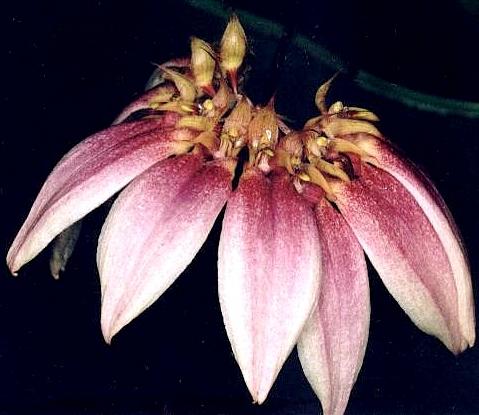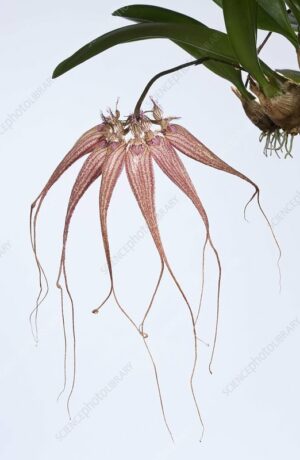


Return to Orchid Growing
BULBOPHYLLUM
GROWING HINTS
GROWING HINTS

BULBOPHYLLUM
The genus BULBOPHYLLUM is the largest one in the orchid family and contains over 1800 species. Bulbophyllums are found mostly in Asia, Australia, South America and the largest in Papua New Guinea and some in tropical Africa. They are epiphytic or lithophytic meaning that they grow on trees or rocks with a creeping rhizome and a pseudobulb with a single leaf. The flowers (like many orchids) are highly unusual to attract specific pollinators.
They come from a diverse range of conditions from the high and low altitudes in rain and cloud forests of most tropical and subtropical countries. They have tremendous variation in their growth habit.
They prefer shaded conditions and constant moisture around the roots. They are happy in a temperature range of 7 to 35 degrees Celsius and will not tolerate frosts. They do like good air movement, like all epiphytic orchids.
They do have fine roots so they do need a little more watering than orchids with thicker roots. They do not need to be completely dry to be watered. They seem to like mosses around their base. Like most orchids more water in summer (the growing period) than in winter when they rest.
Good air movement is extremely important to keep fungal diseases at bay as they like extra moisture and high humidity.
Bulbophyllums can be grown mounted on slabs of wood or tree fern, in baskets or shallow pots. Potting will be dictated by the length of the rhizomes. Repotting should be kept to a minimum as they dislike disturbance. I often place a shallow pot or piece of wood next to an established plant and it will establish itself on the new medium. You can then cut the rhizome to separate the plants.
They tend to flower in spring, early summer and autumn when the nights are a little cooler.
Plants can be divided by cutting a part of the rhizome with at least 2 pseudo bulbs and re potting it in a pot which will give it 2-3 years of growth. Do this when humidity is at its highest and monitor the plant to make sure it is happy in its new situation.
There are a few species like rothschildianum and longissimum which are members of the Cirrhopetalum section of Bulbophyllum orchids because their flowers form a circle which is very attractive.
They come from a diverse range of conditions from the high and low altitudes in rain and cloud forests of most tropical and subtropical countries. They have tremendous variation in their growth habit.
They prefer shaded conditions and constant moisture around the roots. They are happy in a temperature range of 7 to 35 degrees Celsius and will not tolerate frosts. They do like good air movement, like all epiphytic orchids.
They do have fine roots so they do need a little more watering than orchids with thicker roots. They do not need to be completely dry to be watered. They seem to like mosses around their base. Like most orchids more water in summer (the growing period) than in winter when they rest.
Good air movement is extremely important to keep fungal diseases at bay as they like extra moisture and high humidity.
Bulbophyllums can be grown mounted on slabs of wood or tree fern, in baskets or shallow pots. Potting will be dictated by the length of the rhizomes. Repotting should be kept to a minimum as they dislike disturbance. I often place a shallow pot or piece of wood next to an established plant and it will establish itself on the new medium. You can then cut the rhizome to separate the plants.
They tend to flower in spring, early summer and autumn when the nights are a little cooler.
Plants can be divided by cutting a part of the rhizome with at least 2 pseudo bulbs and re potting it in a pot which will give it 2-3 years of growth. Do this when humidity is at its highest and monitor the plant to make sure it is happy in its new situation.
There are a few species like rothschildianum and longissimum which are members of the Cirrhopetalum section of Bulbophyllum orchids because their flowers form a circle which is very attractive.
Let nature be your guide
























